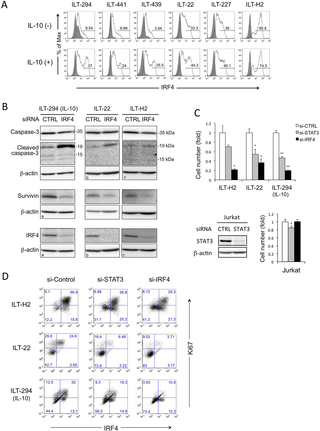PLoS Pathogens ( IF 5.5 ) Pub Date : 2017-09-14 , DOI: 10.1371/journal.ppat.1006597 Leila Sawada 1 , Yoshiko Nagano 1 , Atsuhiko Hasegawa 1 , Hikari Kanai 1 , Kai Nogami 1 , Sayaka Ito 1, 2 , Tomoo Sato 3 , Yoshihisa Yamano 3 , Yuetsu Tanaka 4 , Takao Masuda 1 , Mari Kannagi 1

|
Human T-cell leukemia virus type-1 (HTLV-1) causes two distinct diseases, adult T-cell leukemia/lymphoma (ATL) and HTLV-1-associated myelopathy/tropical spastic paraparesis (HAM/TSP). Since there are no disease-specific differences among HTLV-1 strains, the etiological mechanisms separating these respective lymphoproliferative and inflammatory diseases are not well understood. In this study, by using IL-2-dependent HTLV-1-infected T-cell lines (ILTs) established from patients with ATL and HAM/TSP, we demonstrate that the anti-inflammatory cytokine IL-10 and its downstream signals potentially act as a switch for proliferation in HTLV-1-infected cells. Among six ILTs used, ILTs derived from all three ATL patients grew much faster than those from three HAM/TSP patients. Although most of the ILTs tested produced IFN-γ and IL-6, the production of IL-10 was preferentially observed in the rapid-growing ILTs. Interestingly, treatment with exogenous IL-10 markedly enhanced proliferation of the slow-growing HAM/TSP-derived ILTs. The IL-10-mediated proliferation of these ILTs was associated with phosphorylation of STAT3 and induction of survivin and IRF4, all of which are characteristics of ATL cells. Knockdown of STAT3 reduced expression of IL-10, implying a positive-feedback regulation between STAT3 and IL-10. STAT3 knockdown also reduced survivin and IRF4 in the IL-10- producing or IL-10- treated ILTs. IRF4 knockdown further suppressed survivin expression and the cell growth in these ILTs. These findings indicate that the IL-10-mediated signals promote cell proliferation in HTLV-1-infected cells through the STAT3 and IRF4 pathways. Our results imply that, although HTLV-1 infection alone may not be sufficient for cell proliferation, IL-10 and its signaling pathways within the infected cell itself and/or its surrounding microenvironment may play a critical role in pushing HTLV-1-infected cells towards proliferation at the early stages of HTLV-1 leukemogenesis. This study provides useful information for understanding of disease mechanisms and disease-prophylactic strategies in HTLV-1 infection.
中文翻译:

IL-10介导的信号通过激活STAT3和IRF4途径在人T细胞白血病病毒1型感染中充当淋巴增殖的开关
人类 T 细胞白血病病毒 1 型 (HTLV-1) 可引起两种不同的疾病:成人 T 细胞白血病/淋巴瘤 (ATL) 和 HTLV-1 相关脊髓病/热带痉挛性截瘫 (HAM/TSP)。由于 HTLV-1 毒株之间不存在疾病特异性差异,因此区分这些淋巴增殖性疾病和炎症性疾病的病因机制尚不清楚。在这项研究中,通过使用从 ATL 和 HAM/TSP 患者建立的 IL-2 依赖性 HTLV-1 感染 T 细胞系 (ILT),我们证明抗炎细胞因子 IL-10 及其下游信号可能发挥作用作为 HTLV-1 感染细胞增殖的开关。在使用的 6 种 ILT 中,来自所有 3 名 ATL 患者的 ILT 生长速度比来自 3 名 HAM/TSP 患者的 ILT 生长速度快得多。尽管大多数测试的 ILT 产生 IFN-γ 和 IL-6,但在快速生长的 ILT 中优先观察到 IL-10 的产生。有趣的是,外源性 IL-10 处理显着增强了生长缓慢的 HAM/TSP 衍生的 ILT 的增殖。 IL-10 介导的这些 ILT 的增殖与 STAT3 的磷酸化以及生存素和 IRF4 的诱导有关,所有这些都是 ATL 细胞的特征。 STAT3 的敲除降低了 IL-10 的表达,这意味着 STAT3 和 IL-10 之间存在正反馈调节。 STAT3 敲低还降低了产生 IL-10 或经 IL-10 处理的 ILT 中的存活素和 IRF4。 IRF4 敲除进一步抑制了这些 ILT 中的存活蛋白表达和细胞生长。这些发现表明,IL-10 介导的信号通过 STAT3 和 IRF4 途径促进 HTLV-1 感染细胞的细胞增殖。 我们的结果表明,虽然单独的 HTLV-1 感染可能不足以促进细胞增殖,但受感染细胞本身和/或其周围微环境内的 IL-10 及其信号通路可能在推动 HTLV-1 感染的细胞中发挥关键作用HTLV-1 白血病发生早期阶段的增殖。这项研究为了解 HTLV-1 感染的疾病机制和疾病预防策略提供了有用的信息。











































 京公网安备 11010802027423号
京公网安备 11010802027423号